During the first couple of weeks of July 2015, I was a guest of Wine Tourism in Portugal in the Douro Valley. My mission was to explore the most beautiful wine region in the world and offer you the ultimate guide to travelling the Douro Valley. In this guide, you will find recommendations for the best wine hotels, the best wine experiences, the best food experiences and the best belvederes in the Douro Valley.
In a time where competition wine tourism is at its fierce stage, it would be easy to fall into the century’s old “my wine region is better than your wine region” dispute. This is not what I am here to do. I am here to tell you that, the world of wine tourism is (perhaps has been for a long time) not only restricted to La Rioja, Bordeaux, the Loire Valley, or even Napa.
What is travelling the Douro Valley all about?
The Quintas (estates)
I am here to speak about what makes the Douro Valley unique, showing you what it is like to travel through the oldest demarcated wine region in the world. Yes, that is right, the Douro Valley was established as a wine region for the production of Port Wine in 1756, some 20 years before the independence of America. And almost 100 years before the Bordeaux Premier Crus were established by Napoleon. This means that the majority of the wineries and wine company offices are astounding 18th-century heritage buildings. Almost all have been extremely well-kept and refurbish to today’s modern standards of wine making. Even more interesting is that the Douro riverside palaces where the owners of the Quintas (estates) used as residences are also in prime condition. It is like an open air museum, which can be best admired from the water level, as I explain further ahead in the article.

The family run business
Even though there are over 200 Quintas (estates with its dedicated winery and significant size) and the vast array of DOC and Port wine brands, the great majority of these estates managed to be kept within the founding family’s possession. Some for more than three centuries or more. Great examples of this lineage of Port and DOC winemakers are the Guimaraens family, Ferreira, Silva Reis and Symington. While some heritage buildings have been converted into boutique hotels, others remained private and act as the summer or even permanent residence of some family members who work daily in the vineyards.

The World Heritage
Another aspect that makes the Douro Valley unique is its UNESCO World Heritage classification. A recognition achieved in 2001, in recognition of the long tradition (over 2000 years) of viticulture in this Northern part of Portugal, which produced a cultural landscape of outstanding beauty that reflects it’s technological, social and economic evolution. In addition, the Historic Centre of Porto (the gateway to the Douro Valley) and the Pre-Historic Rock Art Sites of the Côa Valley (next to the Douro Valley) are also UNESCO Heritage sites.

The Autochthonous (Native) Portuguese Grapes
I am not even going to speak about new world wine regions, as the grape varieties that are planted here all come from Europe, so I will only compare it to the European regions. The grape varieties that are grown within the Douro are not only 100% Portuguese, but native to this specific region. Many of them like Tinta Barroca, Touriga Franca, ou Rabigato are direct descendants from the pre-historic vine plants that developed in this terrain and have endured millennia of human presence. Douro DOC or Port wines made only made with 100% Portuguese grapes and we have a lot of them. We do not limit the grape varieties to 4 or 5 like in Bordeaux and the carbon copy new world wine regions. In the Douro valley alone there are more them 200 Portuguese autochthonous grape varieties being used to make Douro DOC and Port Wines. At this moment, more than 500 distinct Portuguese endogenous grape varieties have been classified. For a complete list of all the white grape varieties click here, and for the red grape varieties click here.
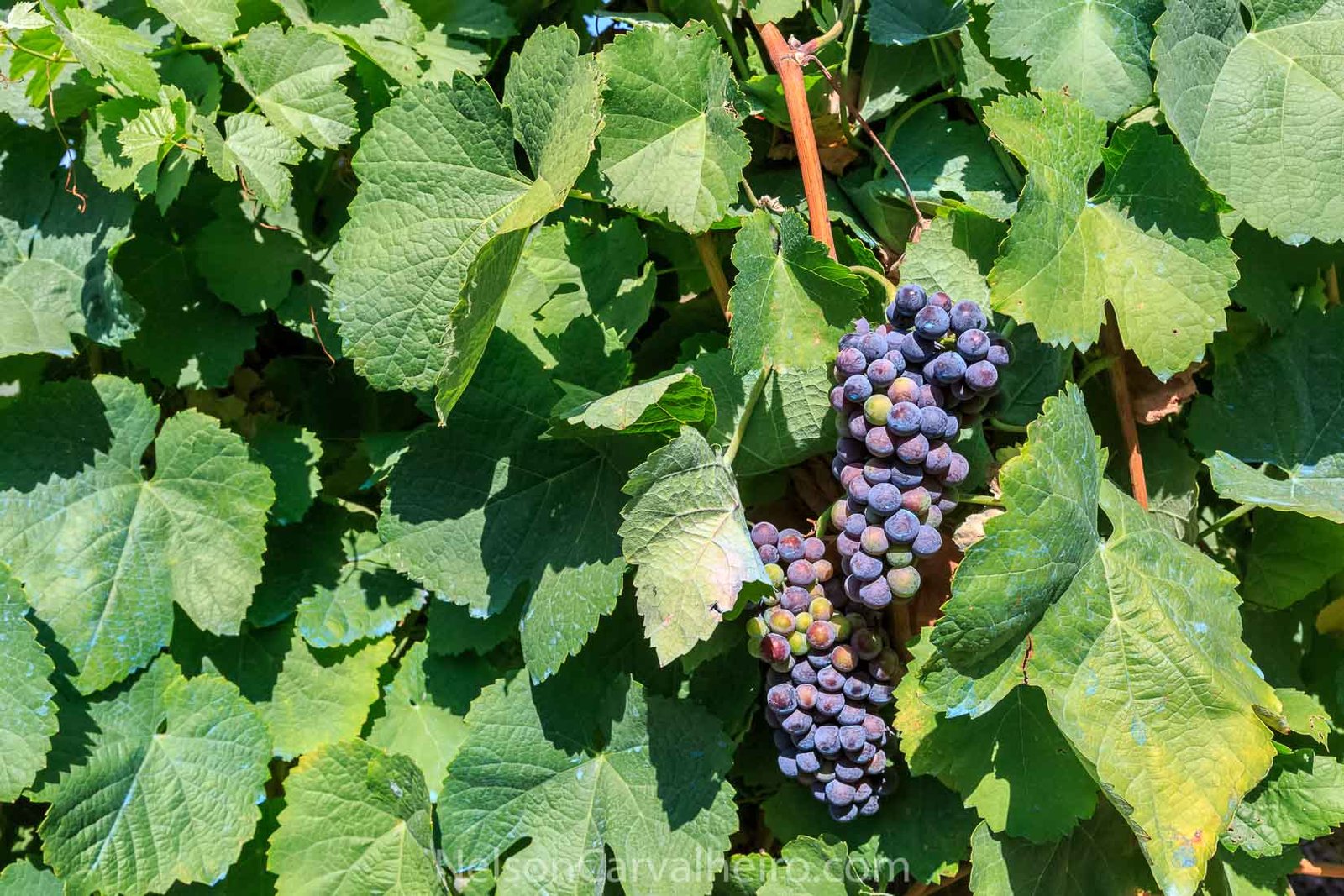
The Terroir
Everyone who works in the wine business will try to tell you how their terroir is unique. They promote the fertility of their terrain, the balanced temperatures, the mild climate, the sea breeze, the frequent rain. They tell you that the vines have everything they need to thrive and that this abundance of substance makes their wines superior. And now look the Douro Valley. The soil is the most infertile ground that you can imagine. It is almost entirely made out of schist, which has less than 5% of organic matter, (in some extreme cases in the Alto Douro the percentage drops below 1%). Normal fertile ground as about 40% organic matter. The terrain is extremely hilly with steep inclines that can reach a 45º angle between the water levels and the top of the adjacent hills. There is very little chance of mechanized labour and still today most of the works on the vineyards, and especially the harvest is done solely by manual labour.
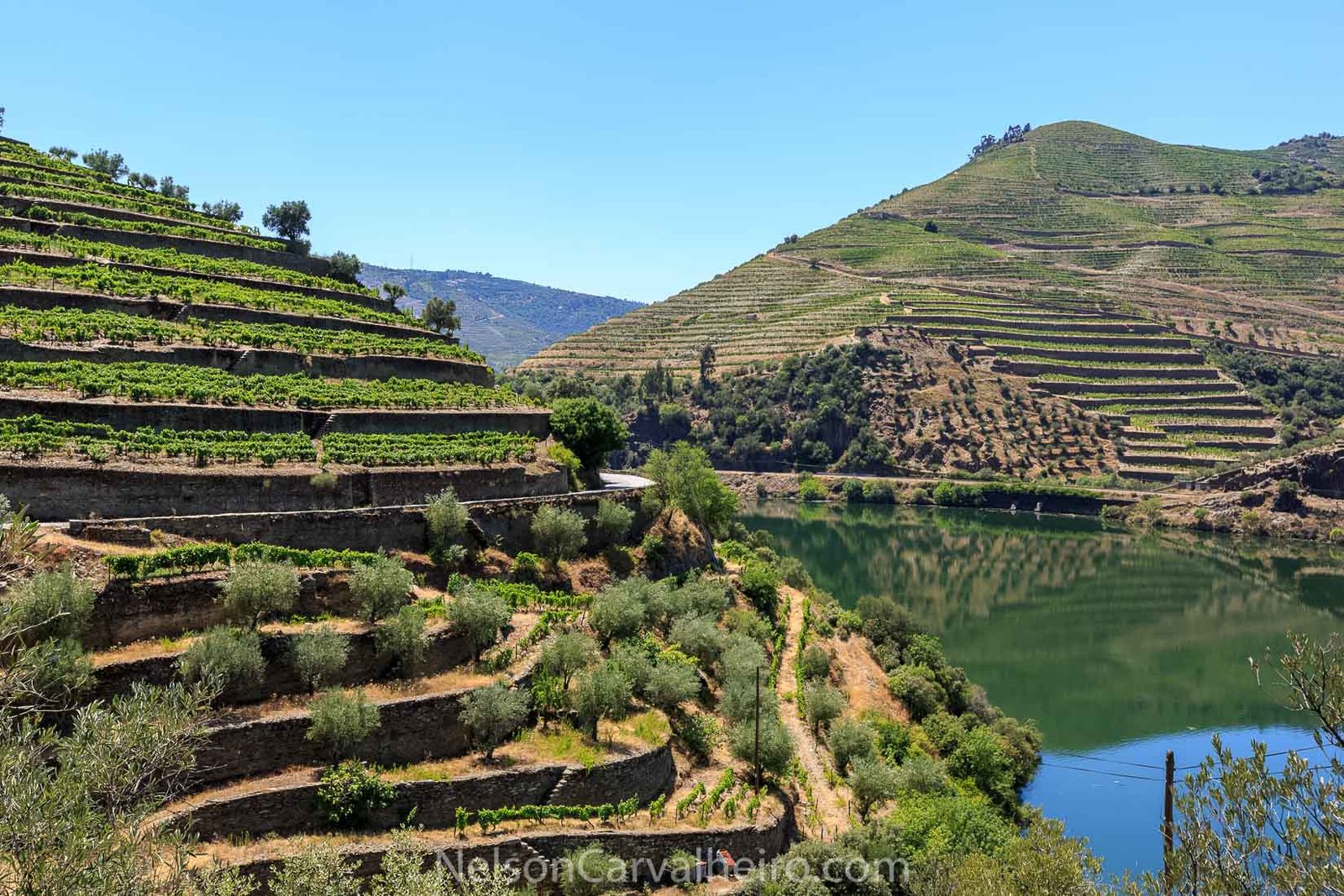
The temperature ranges from cold and around 4 or 5 Celsius in winter, to a scorching 50 Celsius in summer. The local say that a year has 9 months of winter (October to June) and 3 months of Hell (August, September and October). They call it hell because of the high temperatures and of the stress caused by the harvest. The temperature phenomenon in the Douro Valley states that it is the hottest at the bottom of the valley just above the water line and coolest at the top of the mountain. This is why red grape varieties are planted on the bottoms and are harvested first. Nowhere else in the world are vines planted and wine produced like this. On top of this, rain is scarce throughout the year.
Wine = Life
What you have to think about is that all these factors put together to make it extremely difficult for the vines to thrive. They suffer, they suffer a whole lot and for the first 15 to 20 years of their life, they are just trying to keep alive. They have to bury their roots deep in the schist to search for water, as irrigation is forbidden by the IVDP – the Douro and port wine governing the body. They have to struggle for space – the vineyards are planted very close together, never more than a 1.5 meters apart, and in the case of the old vineyards, the ones with 50, 60 or 70 years old vines, that gap closes down to about a meter. Amazingly there is no competition between grapevines when they are planted so close, so they do not spread their root system into the sides, rather into the earth.

All this violence, all this aggression makes the vines work intensely hard to survive throughout their whole life. This results in an extremely effective behaviour when it comes to producing offspring – the grapes that will make sure the continuation of the species. This happens due to plant life resources being scarce, obliging the plant to produce a grape with a most guarantee that they will manage to survive in this harsh environment.

This translates into a variety of aspects that makes this wine region and the wine produced in it unique. The vine as a plant never grows abundantly, and it only produces the necessary leaves and the necessary cluster (bunch) of grapes to make sure its survival. The stomps are thick and sturdy and the roots are buried deep in the mountains (some as far as 30 meters below ground). All this colossal effort results in grapes with an immense concentration concentrated in nutrients and sugars – the distinct full body “flavour” which one can feel when the wine is made, and that are essential to feed the grape seeds. These are also covered and filled with vital oils and the skin of the grapes is thicker than the average to prevent the evaporation of water.
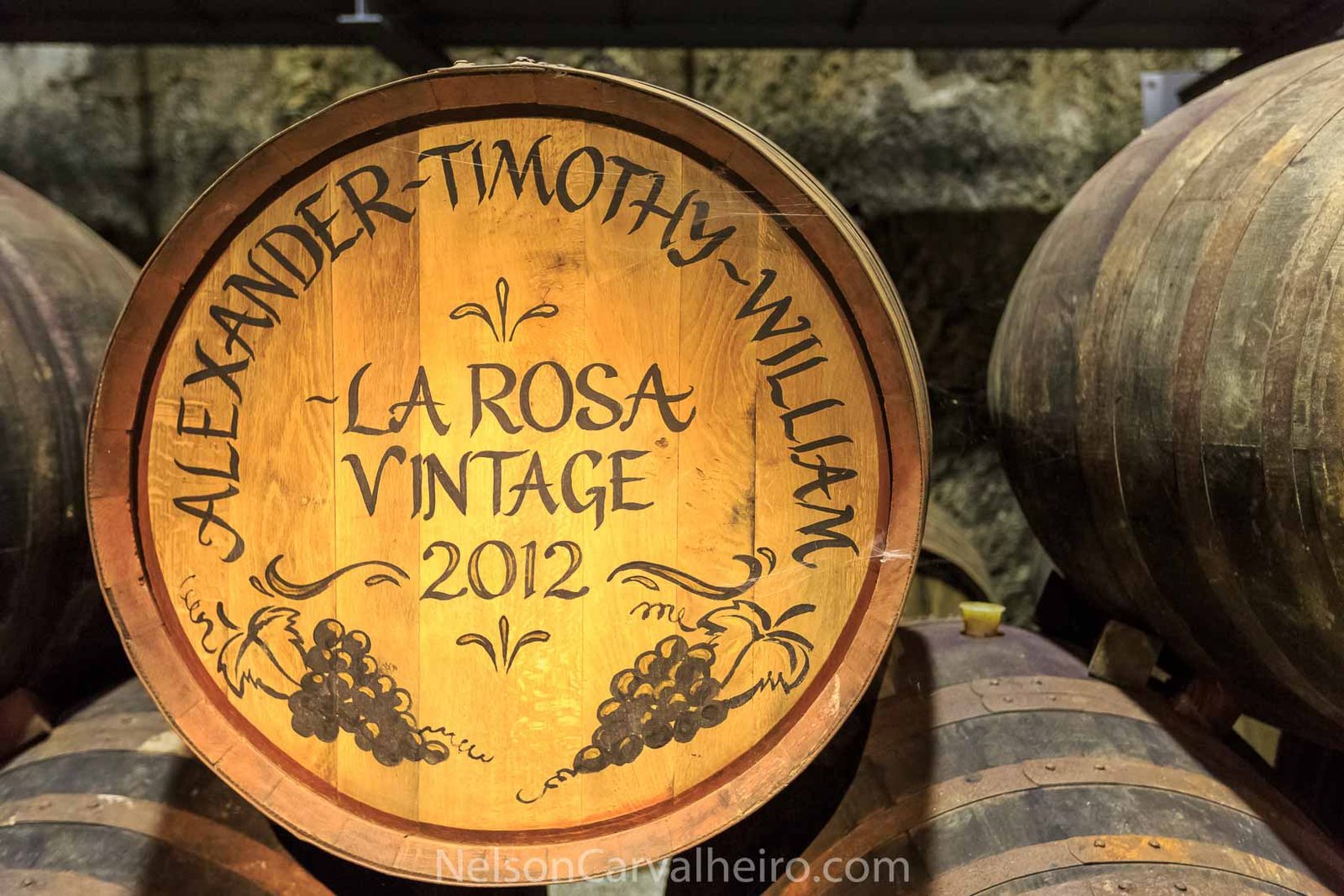
I wrote this long introduction because it is important for me to portray the link between the realities of the Douro, to the characteristics of the wines that are produced here, to the plants who produce the grapes to the people who make their life all about wine. It is only when you as a visitor understand all of this, is that one can truly take the full advantage of what it is like to tour the Douro Valley.
Best Wine Hotels in the Douro Valley
My top choices for accommodation in the Douro Valley. As the properties, all have a very limited number of rooms you can find other options like the Douro Scala in the Wine Tourism in Portugal hotel search tool.
Quinta da Pacheca in Régua
Quinta da Pacheca is the poster child of an ancient winery being adapted to the modern demands of the modern wine traveller. The main houses in the centre of the estate were recently renovated into a chic – boutique – luxury wine hotel. It very elegantly mixes some modern and contemporary elements in a way that one can understand that the owners never lost touch with the Quinta’s heritage. The restaurant is proudly served by Chef Carlos Pires, a man from the interior Northwest of Portugal (Trás-os-Montes – my favourite part of the country) so traditional bold Portuguese flavours are in the main driver in an elegantly plated menu.

It serves the best breakfast of the whole of the Douro Valley, so it is worth to take your time to appreciate the view of the dining room while dipping your bread with cured pork loin on some cold pea soup – it is what the workers in the vineyards eat, so you might as well try it.
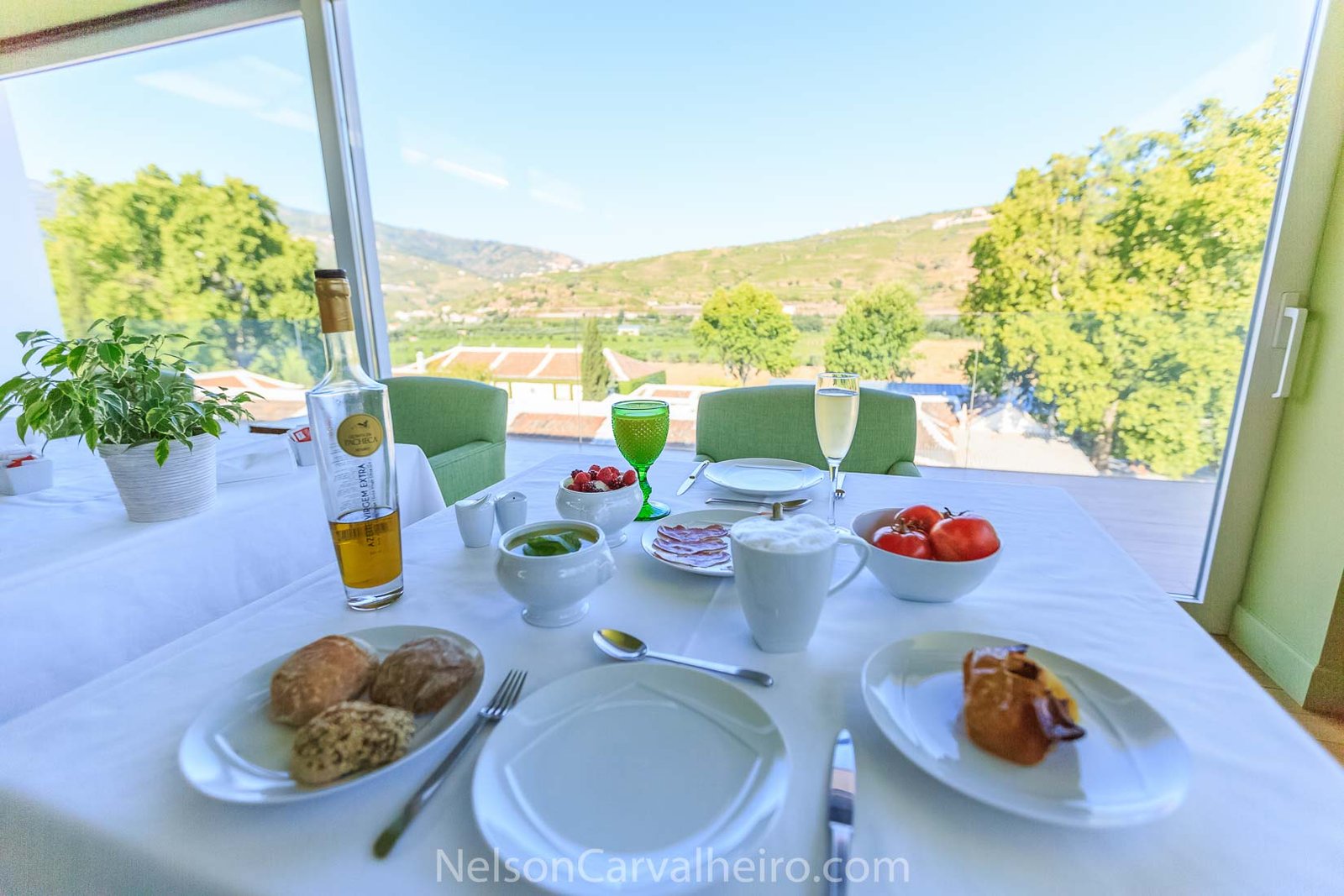
I love that the rooms have big windows and that these are still in their vintage form. The decoration is sober and does not overrun you with wine theme with elegant pastel tones. There is also a vast garden and relaxation area around the main house, and since this is the flattest of the Quintas in the Douro, you can actually take a stroll on the vineyards without needing hiking boots. For all the other vineyards, they are strongly recommended.
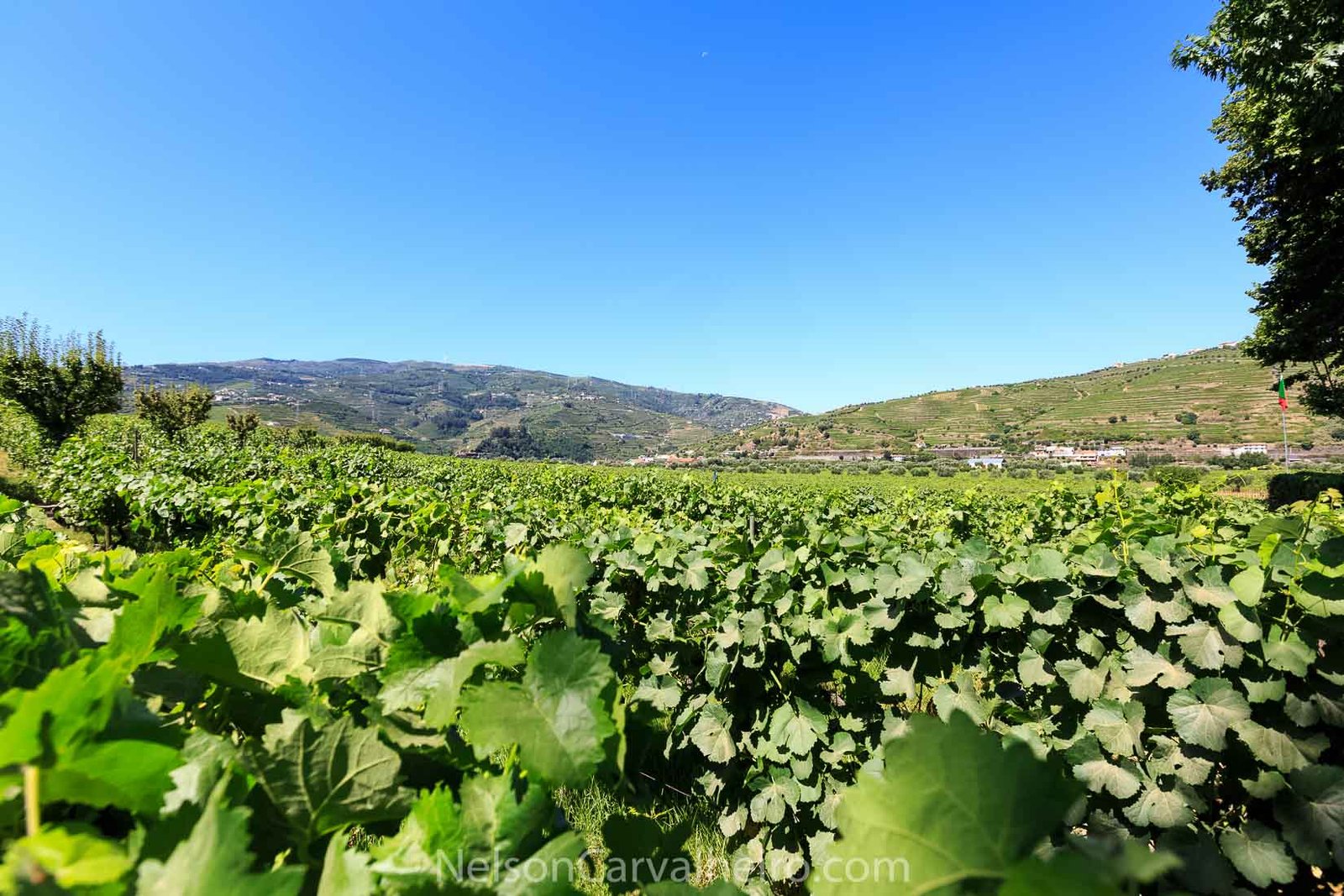
Quinta de La Rosa in Pinhão
What I love more about Quinta de La Rosa is that all the rooms and suites look into the river. Not only the view is beautiful by nature, but it becomes, even more, spectacular when the sun is setting behind you, illuminating with a golden hue the landscape visible from your room. Even though the estate is not the biggest in the Douro, it feels very spacious and not crowded at all as the rooms, suites and villas are scattered throughout the vineyards. Some rooms bring you so close to the water, you could almost fish from your balcony.
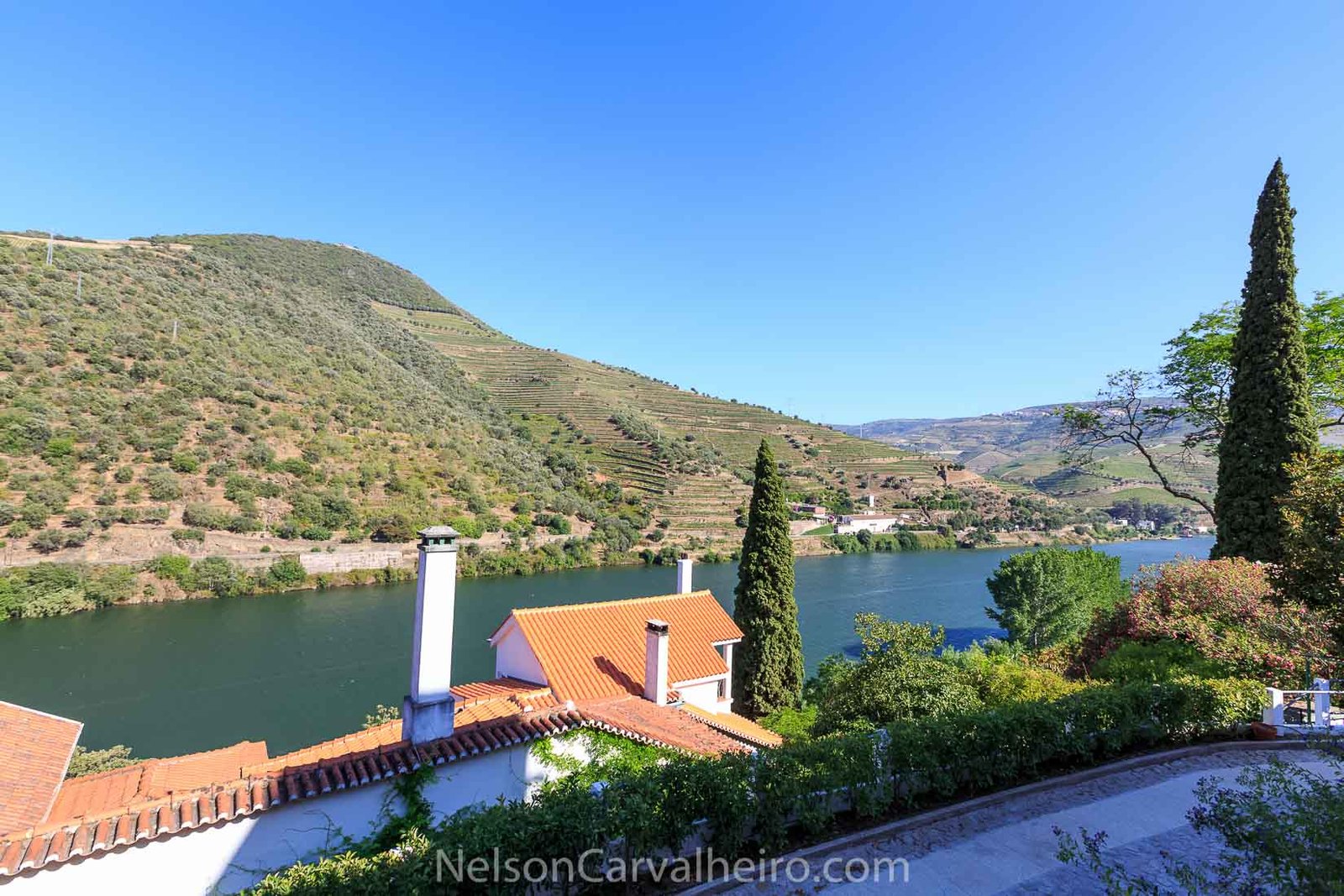
Quinta Amarela is one of the estates private villas, located a few minutes’ walk from the main building. If you are lucky enough to find a vacancy, then I strongly suggest you book it immediately, as it is the closed that you will ever get to having tour own little Douro Valley private estate for a few days. There is also another option for a private villa rental, the Casa das Lamelas, but this one is high up on one of the hills behind Quinta de La Rosa, so the view is not as spectacular as the one from Quinta Amarela. The best thing about Casa Amarela is the private pool (4m x 8m), situated in the interior courtyard with a barbecue on the nearby terrace.
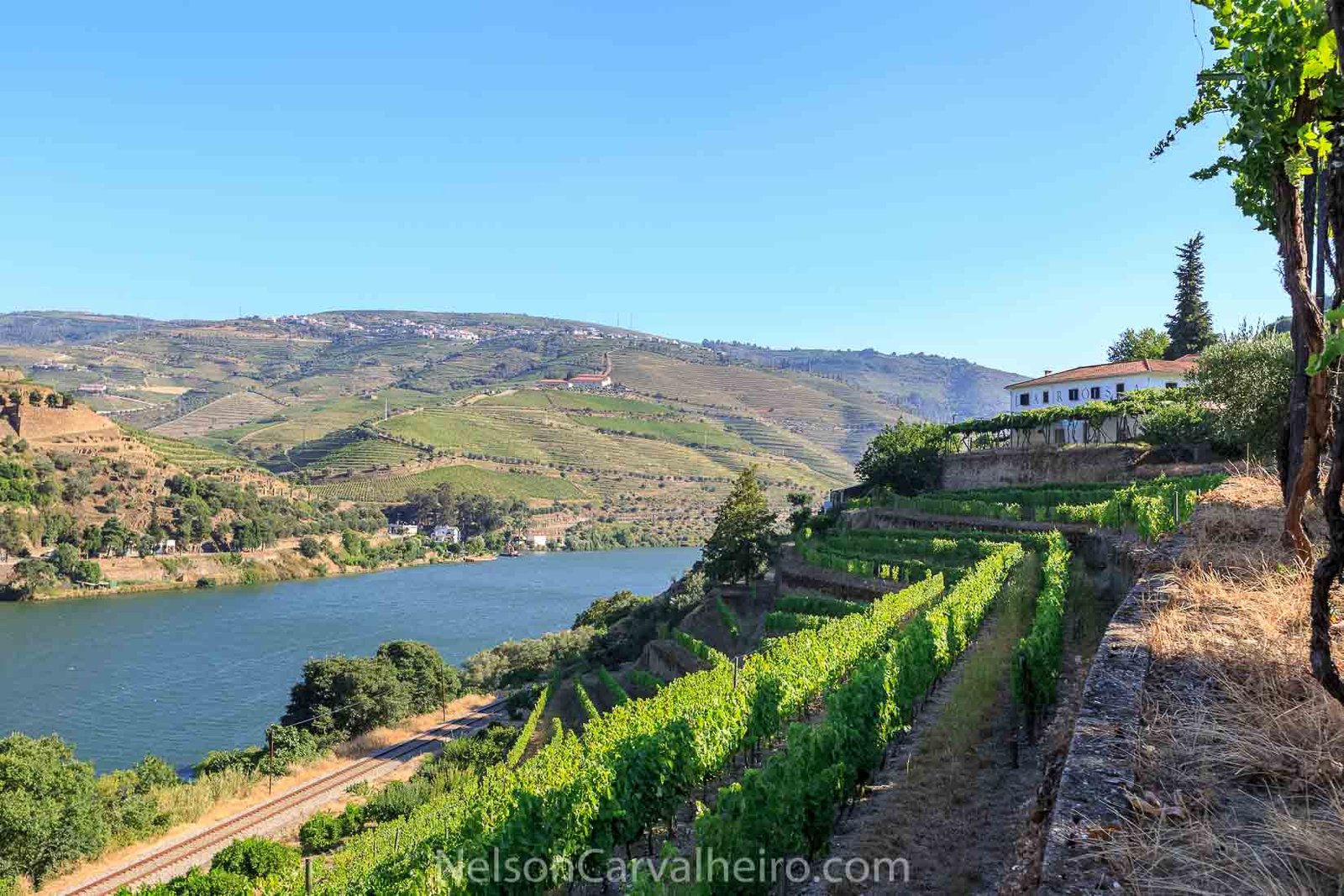
I stayed in the Donna Sarah Suite, named after one of the grandchildren of the owning Bergqvist family. Actually, all the rooms have a name connection to a member of the family. A sort of tradition within the family, much like the one where they have their names engraved on a special edition of Port wine date of the year they were born. My suite was (Britishly) decorated in blue and white, reminding me of the double influence that is spread out in this region. The two levels make it easy for a family of four to sleep comfortably without compromising privacy. The little terrace in front of the door is the best option for some late night conversations or for a bit of privacy at breakfast.

At the time of my visit a new restaurant by the water was still being built so my breakfast happened on the terrace adjacent to the main building. The light from the rising sun shines unimpeded on the raised eating area so sunglasses are a must.
Vintage House Douro in Pinhão
Vintage Douro House is the by far the closest the superior Douro area around Pinhão gets to a full-service five-star hotel. The Vintage House Douro brings a bit of class and style to the Douro, giving travellers a more mainstream accommodation offer than all the rusticity of the nearby Quintas. I stayed in the suite 120, a master suite in the corner of the building with a spectacular view of the gardens, the pool, the river and the mountain. Plus, the little balcony is just big enough for two persons and a bottle of wine, making it the perfect choice for a romantic weekend in the Douro Valley.

The decoration is all about wine and made to resemble what the inside of a “19th century Douro wine house” must have looked like. In my honest opinion, the best assets that this hotel has been its GM Márcia Coelho and its FOM Guida. Two lovely ladies who know the region and its players personally and who can recommend the Douro like true insiders.
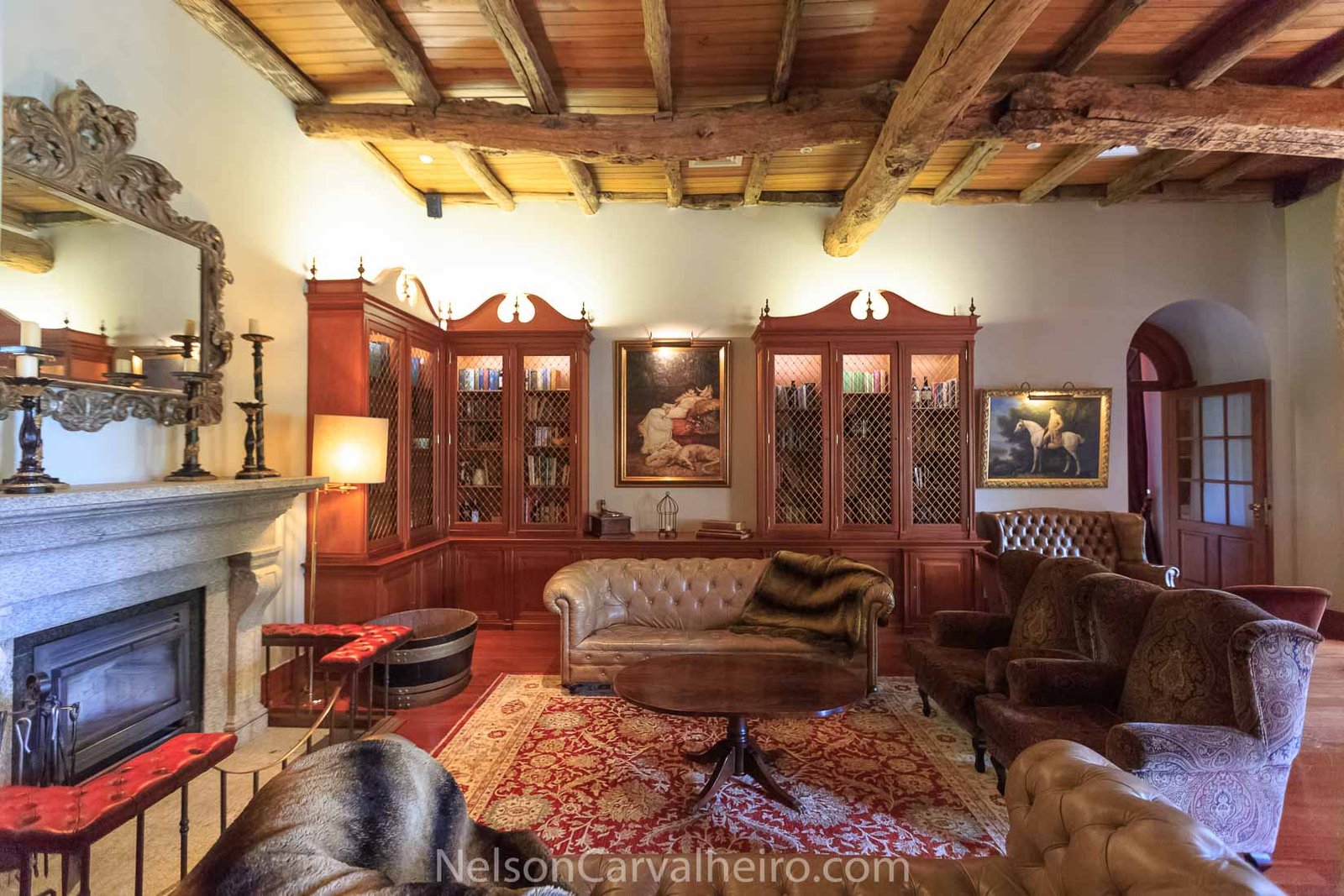
The al fresco restaurant and gardens are the highlights of the hotel, and where I had dinner after my private sunset yacht tour. As the hotel is right on the water, all I had to to was to walk a few meters from the pier to my table in the garden. From the 5-course tasting menu, the sardine ceviche was my favourite. In a nutshell, the Douro Vintage House is the closest the Douro gets to an Italian villa hotel, but without the snobby waiters and with a better view.

Best Wine Experiences in the Douro Valley
On this chapter, I choose to recommend wine experiences, rather than tours of vineyards or visits to wineries. Let’s face it, no one takes absolute pleasure from looking at towers of stainless steel while having a tour guide describe the fermentation process for the 10th time that day. Here, I focus on the out of the box experiences that some of the Quintas offer, and which I find 100x more rewarding to you as a visitor and as a wine enthusiast.
Vintage Tour at Quinta da Carvalhas
The Vintage Tour at Quinta das Carvalhas is the best wine experience in the whole of the Douro Valley!
I know it comes as a bold statement, but believe me, there is nothing even resembling it out there. It is the prodigal idea of Alvaro Martinho, the agricultural engineer at Quinta das Carvalhas and its operations manager. Disappointed with the way other Quintas neglected its visitors, he found a way to transmit to wine travellers what the “Douro Valley sense of place is all about”.

In case you skipped it, a great part of the introduction to this Douro Valley Guide is based on the 3,5-hour conversation that I had with Alvaro while he was driving me around the enormity that is Quinta das Carvalhas. It is the largest Quinta in the Douro with a colossal 600 hectares. He is a very interested man, a man that feels the earth, the soil, the grapevines, the plants and the weather as if they are integral parts of himself. From his perspective, it is natural to start the story with how the Douro Valley was formed and how the grapes have sculpted, not only the terrain but the lives of the people that have chosen to make their life about wine.
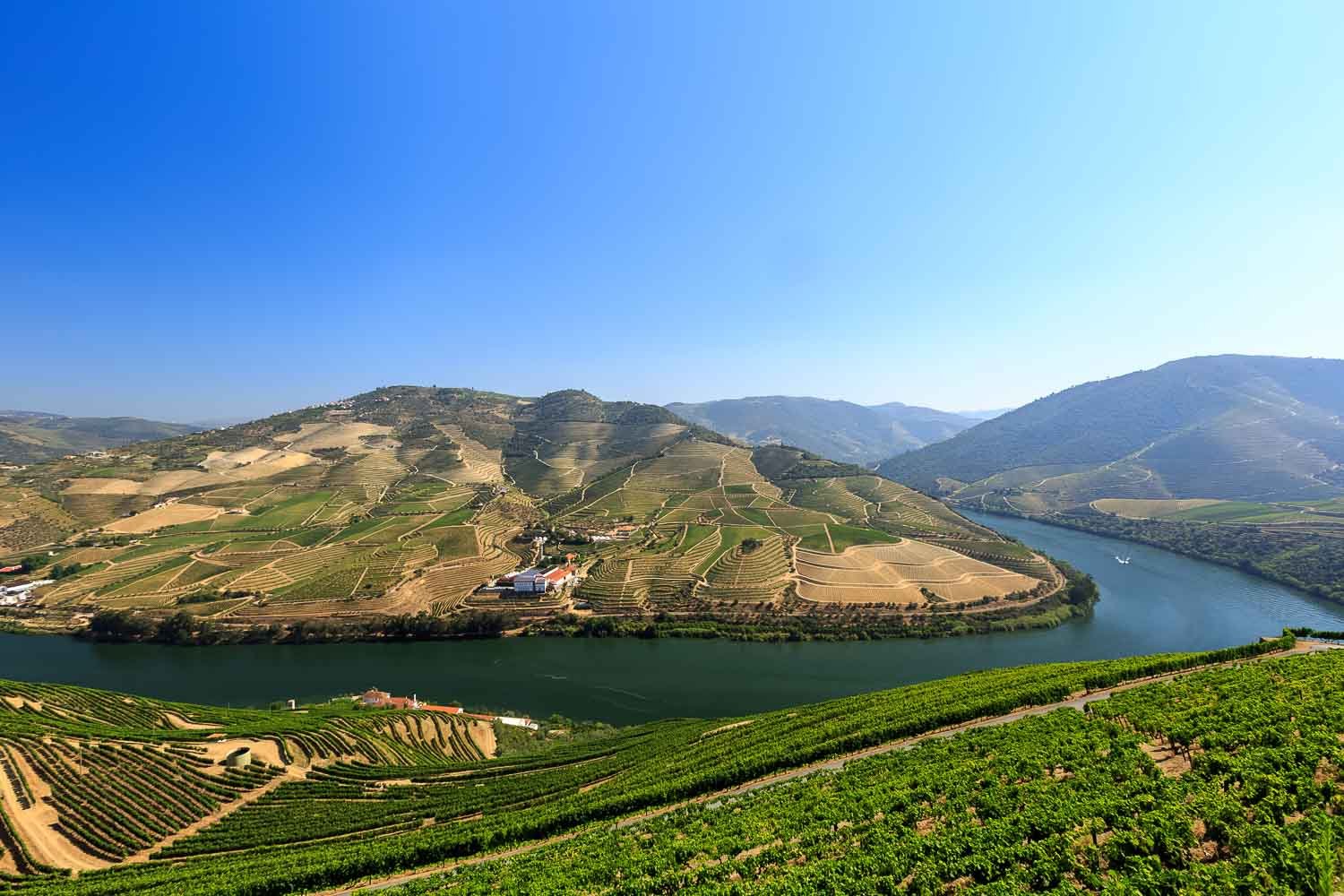
He knows all grape varieties that are planted at Quinta das Carvalhas and tells the story about how the vineyard is a like community of well-behaved neighbours that work together in harmony, allowing each vine plant to produce the best grapes that it can. On top of this, his enthusiasm in telling this story takes place in some of the most breath-taking vantage points over the Douro, making his storytelling even more special.
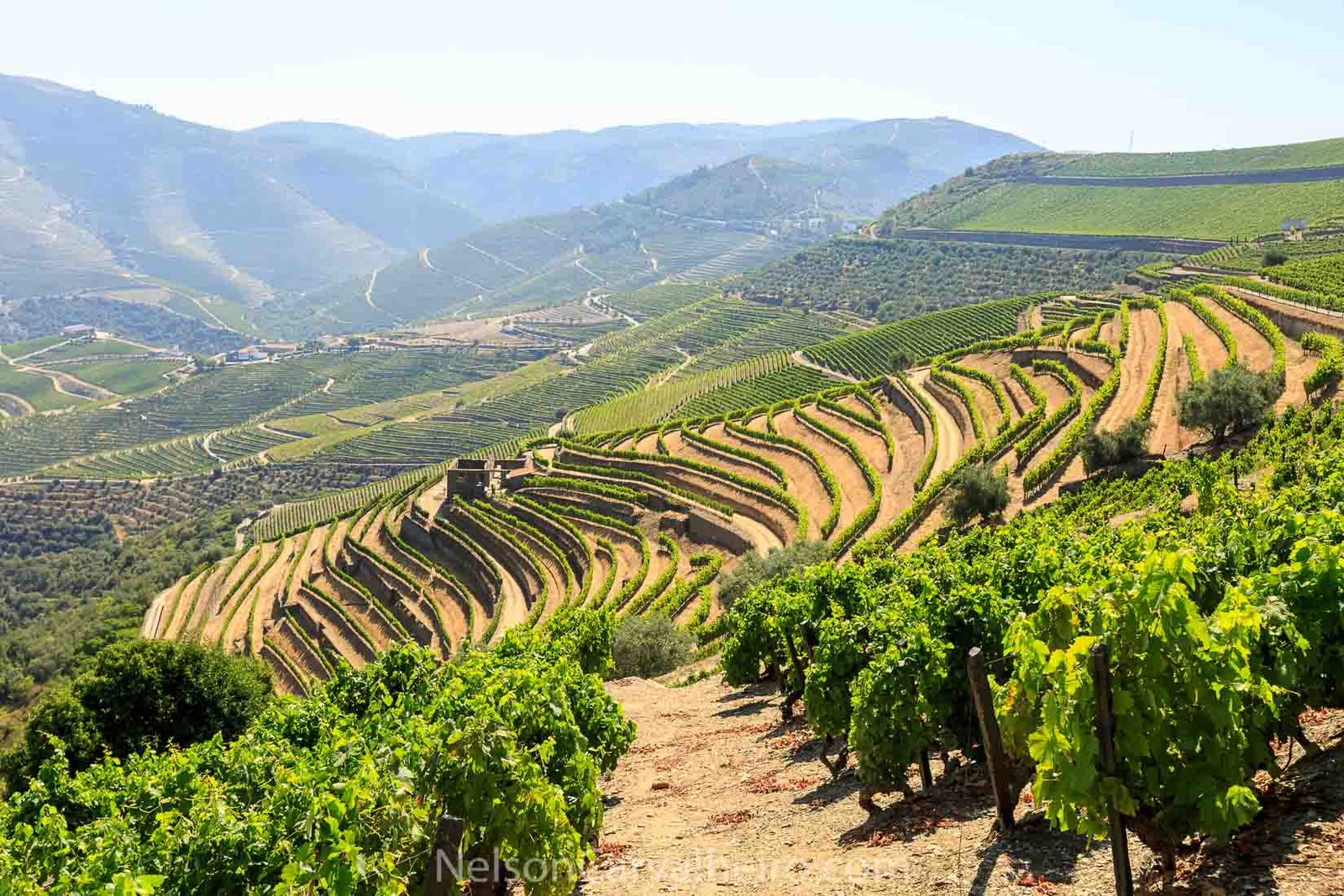
Hopefully, at the end of this tour you will understand that, when you drink a Douro DOC or a Port Wine produced at Quinta das Carvalhas you are only enjoying a good wine, you sampling what this reality is all about. I find the 30 euros per person ridiculously cheap, as I would happily pay 300 or more for so much of a perspective changing the experience.
Winemaker for a day in Quinta Nova
Sónia Pereira is the resident enologist at Quinta Nova and the person responsible for the first ever Carvalheiro’s 2015 DOC Douro Red Wine – the wine I blended with her guidance. I love this experience and strongly recommend it, as it gives you a hands-on approach to DOC Douro Wines. Rather than just tasting and comparing several wines you can make your own blend.
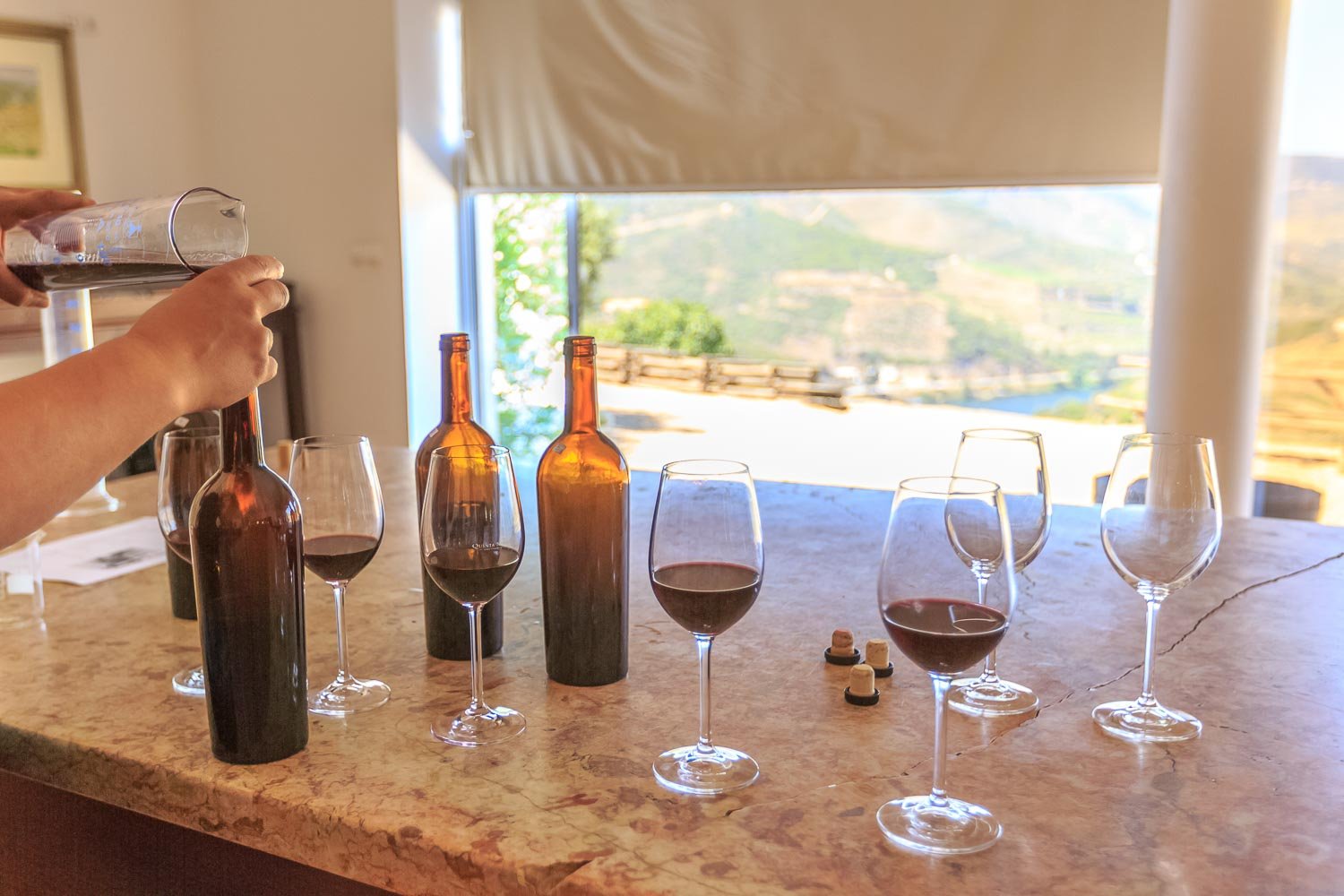
Sonia took 3 samples from different red wines in different resting stages. The first was a 2012 harvest, unoaked with 4 different grape varieties. Batch number two was a 2011 harvest with 1 year of oak maturation with 7 different grapes. The last bottle was 2010 harvest with about 14.2% alcohol with only two distinct grape varieties. Sonia took me through a simple explanation about what each wine is about and what I should look for when I smell and taste each one of them. Then she made 3 different blends according to my wish to have a balanced red, with about 13.5% alcohol, with sharp tannins and prolonged aftertaste. The result was 50% of the fist wine and then 25% equal parts of the second and third. I am no expert, so it didn’t take too long to reach one blend that was good for me. 🙂
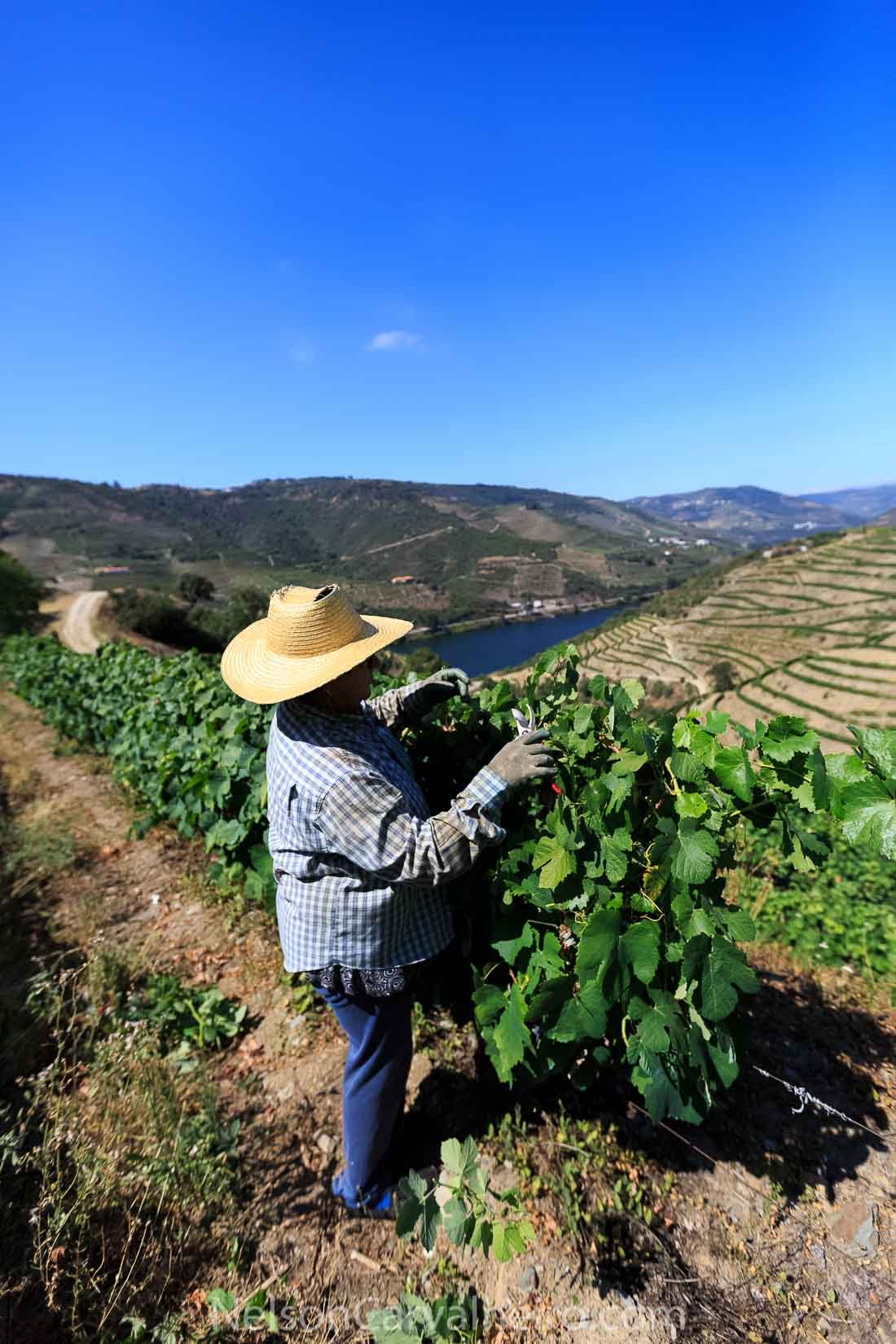
The winemaker for a day experience also includes a tour of the winery and vineyards. However, I recommend that you arrive about 1h hour before so you can explore the several walking trails around the vineyards. If you are lucky like me, you will run into some workers pruning the vines, or even harvesting them (September to October) and learn a bit more about life on the other end of the bottle.

Sunset Douro Wine Cruise
This was by far one of the most enjoyable experiences that I had while touring the Douro Valley. The hilly terrain and the insistence (thank God for this) of bridges can prove to be a difficult when one is hoping from Quinta to Quinta in the Douro. Luckily nature has taken care of this a long time ago and I will say it now: the best way to enjoy the Douro is board a private yacht.
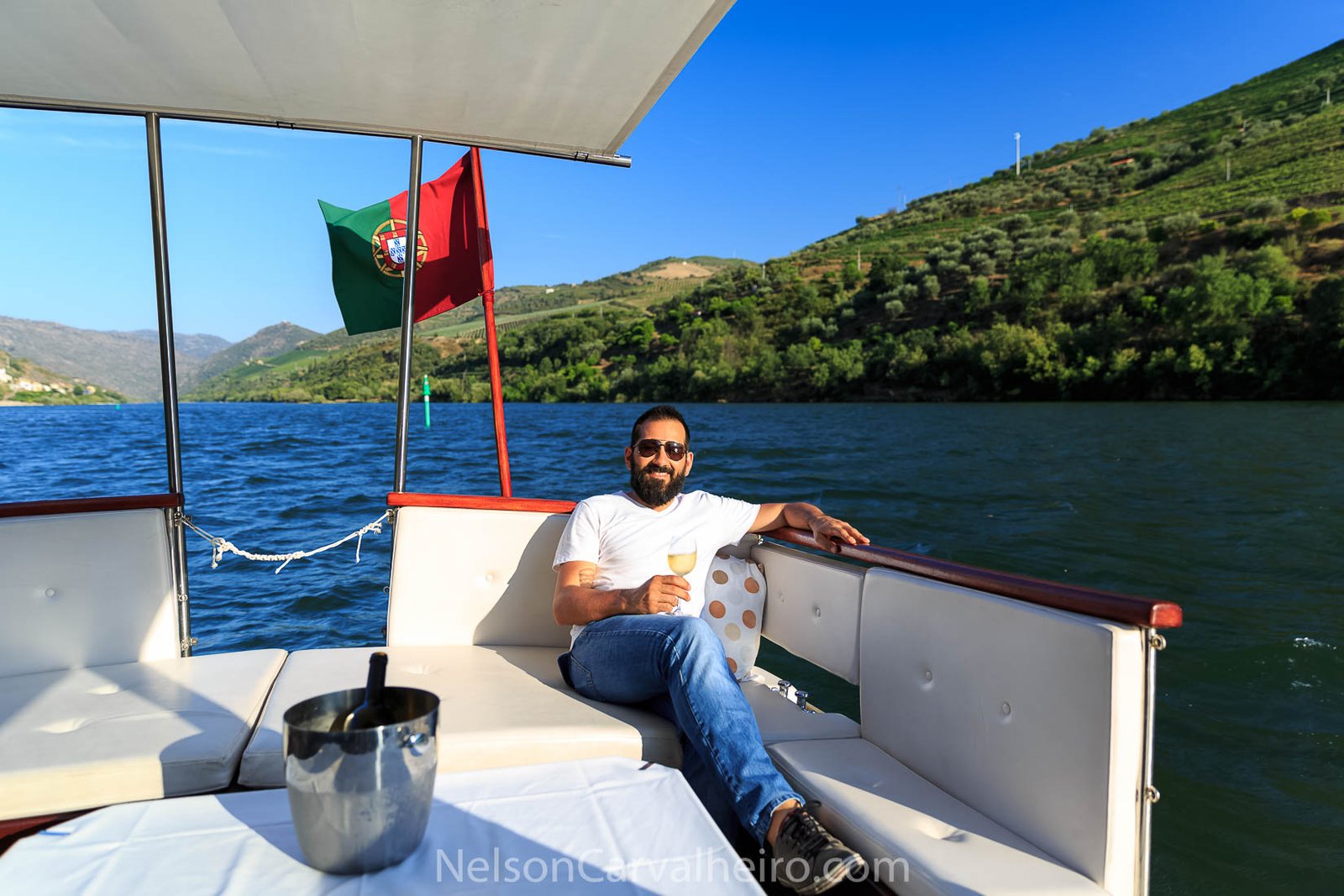
As you can see by the photos my Sunset Douro Cruise was nothing but pure relaxation. Just me, skipper Jorge Silva, some crisp chilled white wine, the water and the unique backdrop of the Douro Valley. I sailed aboard the Pipadouro II, a 10-meter yacht which is comfortable enough for a couple or a small group of friends. With all the dam system that was built in the main river valley, the Douro River is now basically a series of lakes where the current is almost non-existing, so you don’t have to worry about swell or waves.
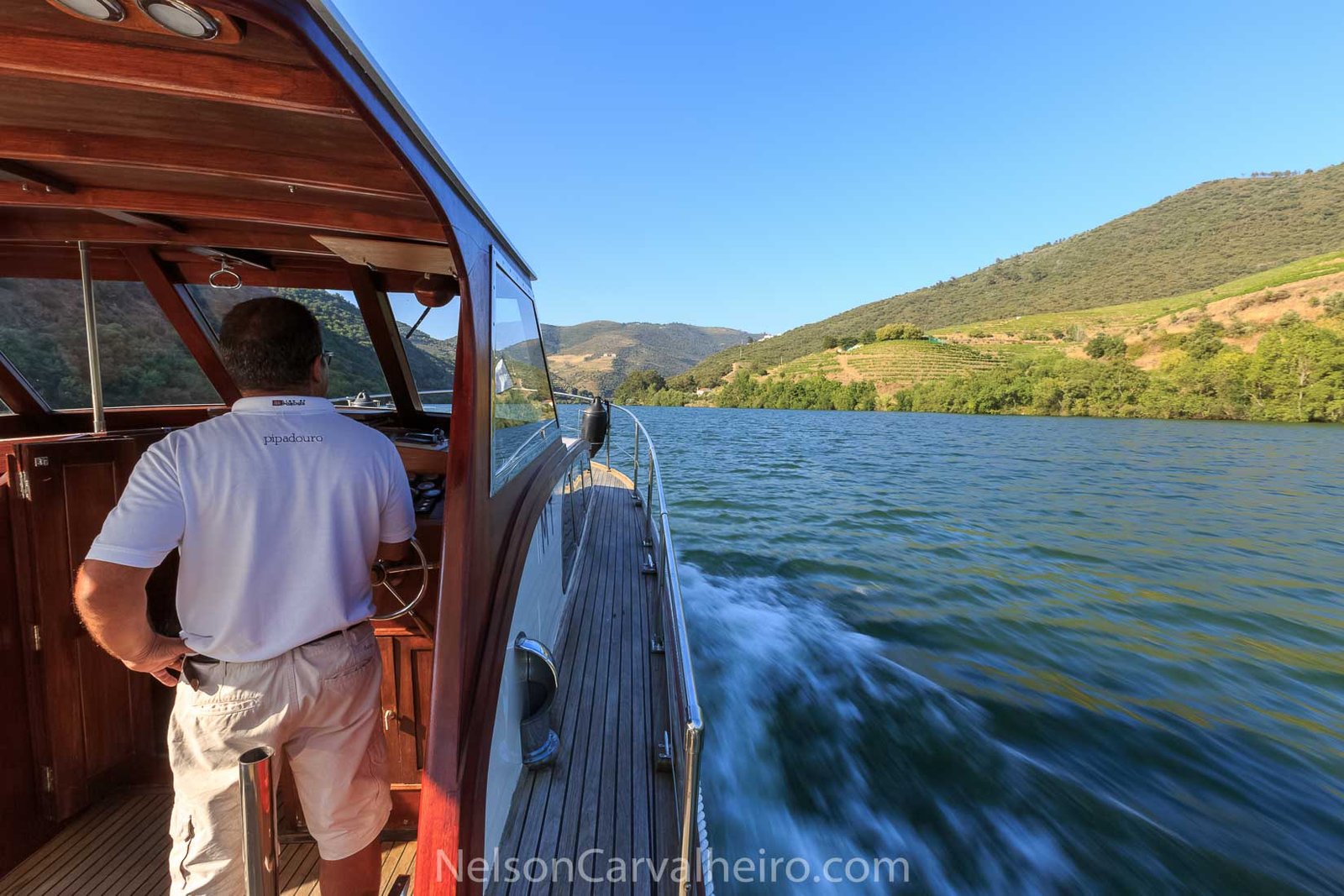
I specifically asked the skipper to travel upstream, all the way to Tua (a small little village) as this would take me to the less touristic part of the Douro. The journey takes about 2 hours (one hour each way) and here you can see all the vineyards, estates and Quintas which are not open to the general public. Some of the most impressive are the Quinta da Romaneira (which used to be a luxury hotel until it was recently bought by 32 Million euros by a Brazilian banker), Quinta do Pessegueiro, Quinta do Roriz, Quinta da Vila Velha, and Quinta dos Malvedos (where the La cage dorée film was shot).

My personal recommendation is to leave this experience for the last day of your stay in the Douro Valley… You will thank me later.
Best Food Experiences in the Douro Valley
One thing that you have to take into consideration when travelling the Douro Valley is that throughout all its history it has been a Port Wine Producing region. Purely! DOC Douro table wines only came out in the last 30/40 years and tourism has really only opened up in the last 10/15. This means that the tourism, hotels and restaurants offer in the Douro Valley is exclusive and very scarce. While a good wine hotel to stay in can be relatively easy to find, the same cannot be spoken about a good restaurant. So here are some of Douro Valley’s top food experiences.
Gourmet Experience at Quinta do Panascal
Even though Quinta do Panascal doesn’t not directly overlook the Douro, its location on the left bank of the Távora River (one the Douro’s most important tributaries both in water and in history) falls nothing short of the exclusivity that it advocates. This estate belongs to the Guimaraens family and the Fladgate Partnership, a colossus of the Port Wine world owning the Croft, Taylor and Fonseca Port wine Brands. What makes the Gourmet Experience at Quint do Panascal so impressive is that you can have a private lunch in the quarters where the Guimaraens family usually has their get together.

When I arrived at Quinta do Panascal, I was gravelly met by Ana Margarida, a PR person of the Fonseca Brand, as this Quinta only produces grapes for the Fonseca Port Wines. We tasted a few Ports, with my attention being grabbed by the bicentenary edition of the Fonseca Crusted Port and the Fonseca Terra Prima, the world’s first organic certified Port wine. After, we moved to the upper floor where a table big enough for 20 was set for two. I felt like a royal… The table cloth had been ironed and one of the family’s finest flatware and silverware was set. I can image this space on a Sunday afternoon, the family lingering on the now dirty table cloth watching the children play in the terrace.

Since the company only produces Port Wine, they usually recommend the Douro DOC wines from Quinta do Crasto, which accompanied our prawn salad starter and our main course of Rojões. I have to confess that I don’t have a photo of the Rojões – small cubes of fried pork loin because I was too busy eating them. Sorry. For dessert a classic of home-made chocolate mousse with the new Fonseca Terra Prima. You need time to enjoy all of this, so I recommend not to have anything else booked for the afternoon, as you too will want to linger on at the table of the most important Port Wine producer in the world.
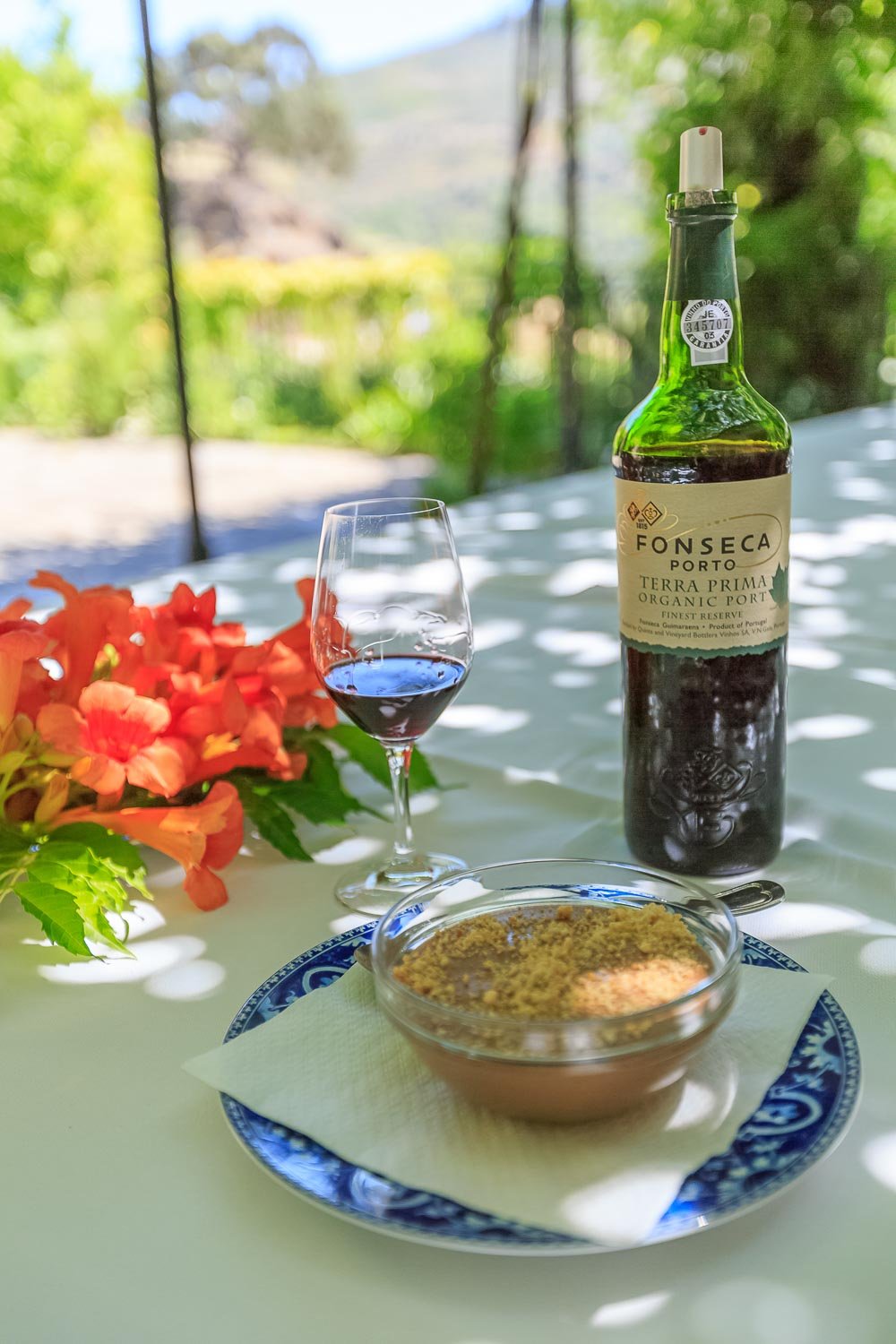
Picnic with a view at Quinta do Pôpa
Quinta do Pôpa are the new boys in town. They have only been open for a couple of years, and while the estate does not have any heritage to look at, they are surely the most progressive and modern traveller oriented Quinta in the Douro. Instagram frame, hashtag t-shirts, a sweet red wine who’s not a DOC, not a late harvest and not a Port either – Pôpa Doce. They are breaking the paradigm of the “old and establish” Douro houses and are coming with some very interesting products and experiences, such as a wine brunch or the Pôpa Picnic.
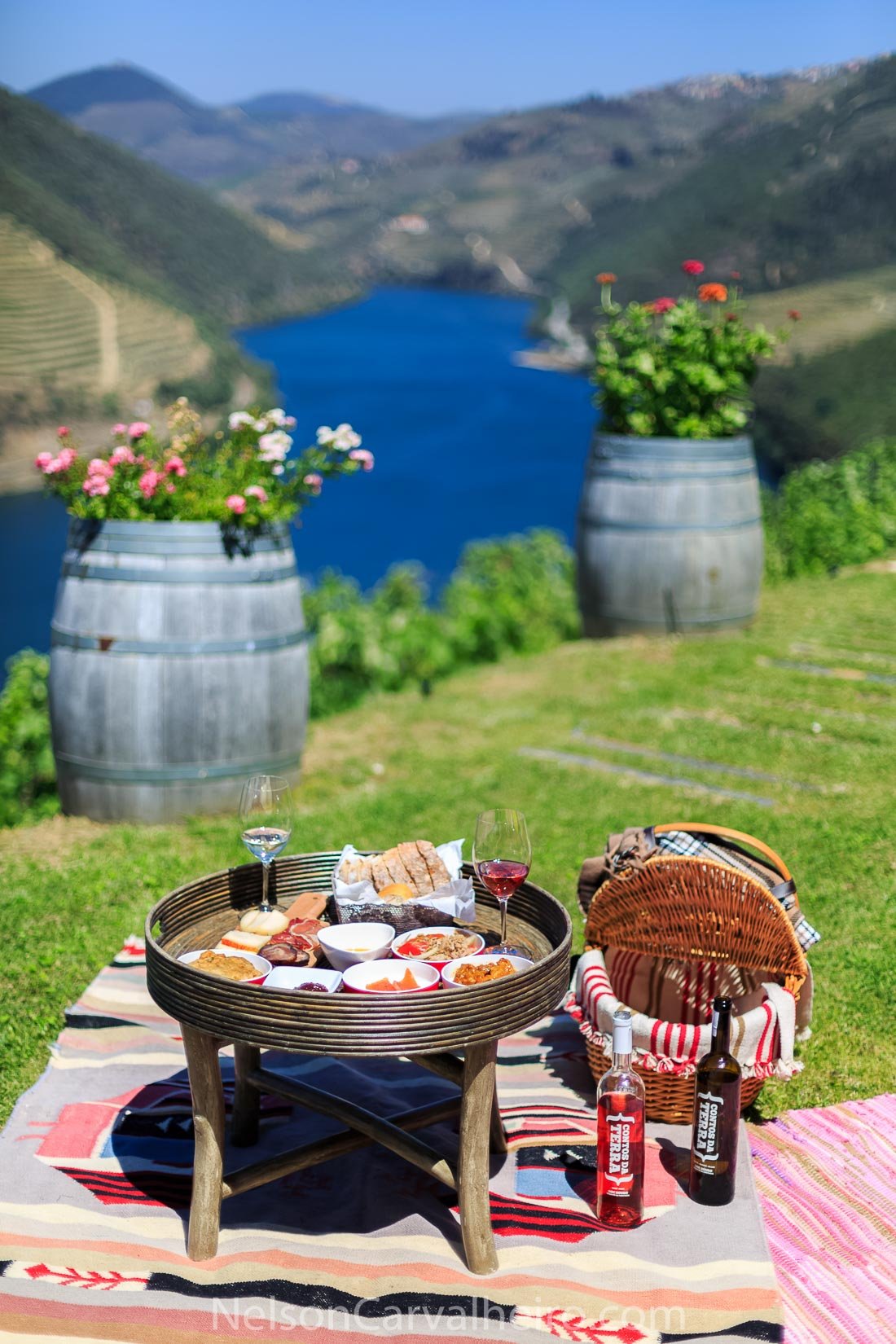
What this Quinta has and what is the best thing about it is the view. It sits on vineyards with a very strong incline to the river. This offers a unique vantage point to enjoy your Picnic with a view. You are free to walk around the vineyards and lay the blanket where you are most comfortable, but I strongly recommend that you stay within the green grass areas around the main house. Its ground is much softer and with no incline. Plus the view is not impeded by the vine leaves.

This is what it is all about – enjoying some traditional Portuguese food while admiring the most beautiful wine region in the world. The Pôpa Picnic is like a Christmas hamper full of Portuguese food goodies and delicacies. The items vary according to the season, so I was given a summer menu which included: tuna and garden vegetable salad, rustic bread, stewed chicken giblets, cod fish fritters (two national institutions of the Traditional Portuguese food Panorama), a selection of semi-cured regional goat and sheep cheeses, a selection of charcuterie, the estate’s own olive oil and the also homemade quince and loquat jams. To accompany this Portuguese takeaway banquet, I there was two bottles of Conto da Terra – a white and a rosé, which are Quinta do Pôpa’s entry level wines – light, easy to drink and very enjoyable with all this gorgeous food offerings.
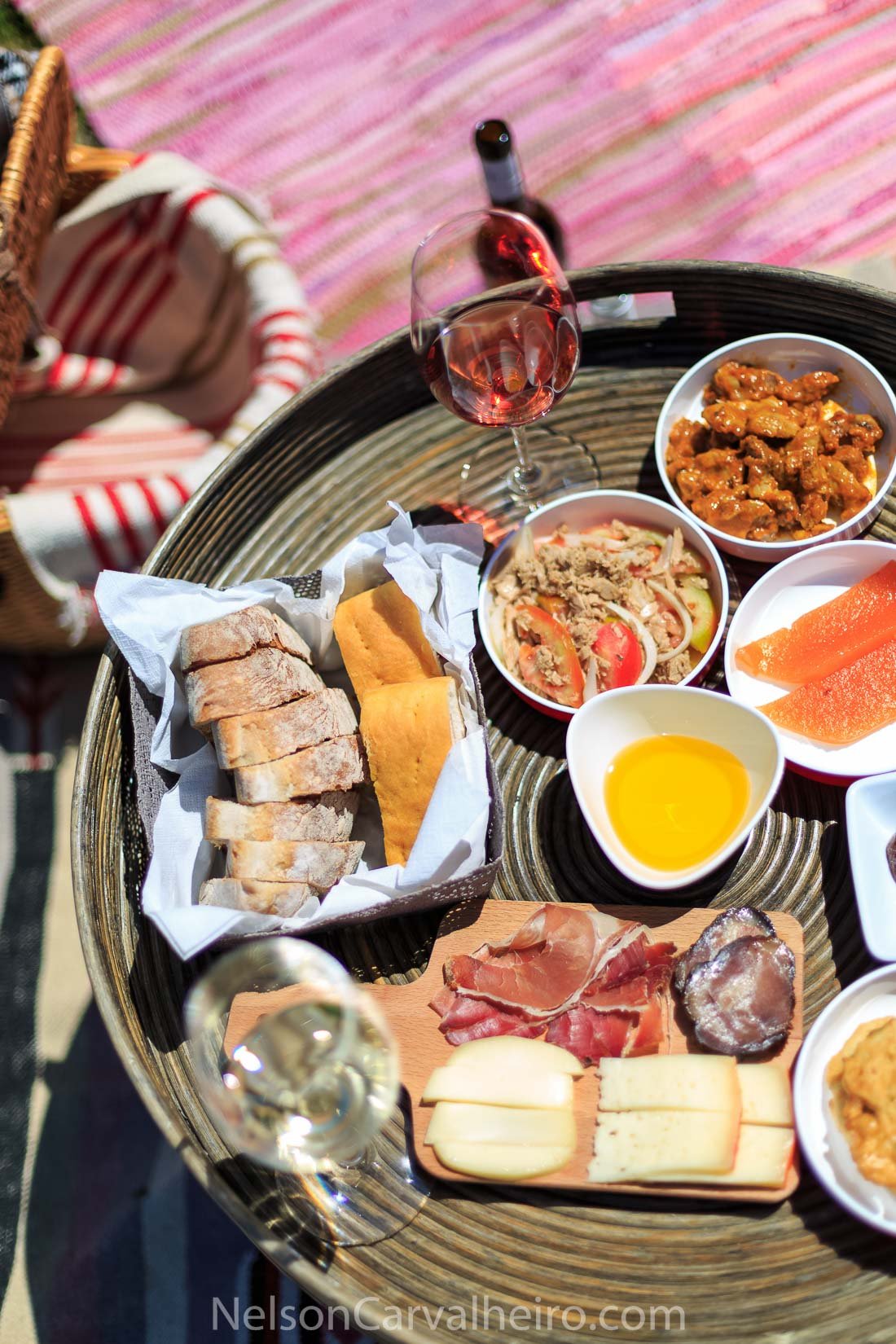
You can also turn the Pôpa Pic Nic into a brunch as there will be plenty of food to last you the rest of the day.
Castas e Pratos Restaurant in Régua
Castas e Pratos ticks all the boxes when it comes to showcasing the best of traditional Portuguese cuisine with a modern twist while offering over 700 different wines. This makes them one of the complete bars in the whole of Portugal. The brilliance of the idea for this restaurant was to create a space where a vast array of wines from the region could be tasted while offering a modern take on the bold flavours of the Douro and of the North of Portugal.
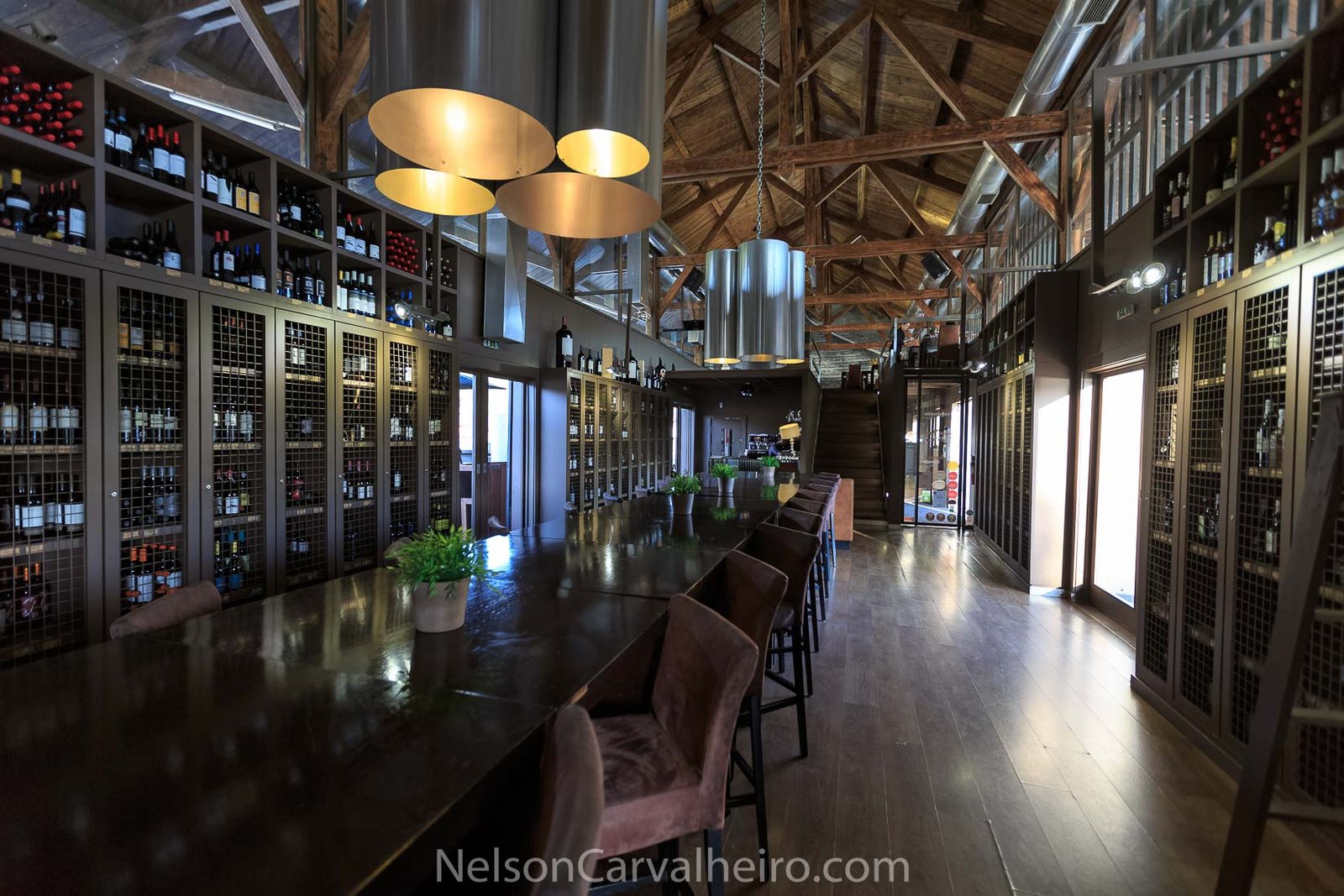
What makes it, even more, interesting is that the restaurant is housed in a converted old railway station warehouse. On the inland side, you can have a private evening next to the old rail tracks and dine in an old cargo rail car. The front side of the restaurant has some gorgeous views to the Douro, so you are spoiled for choice.
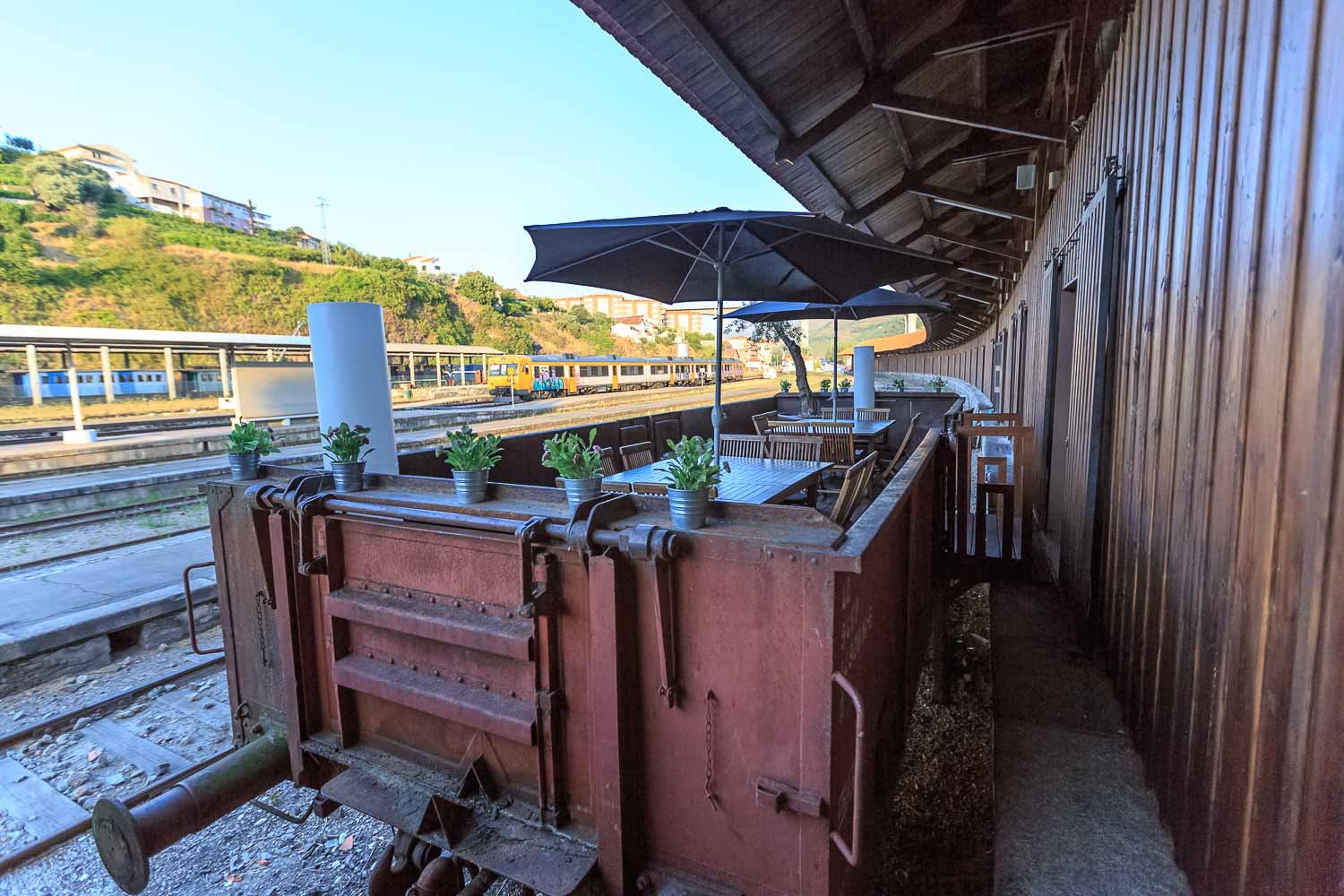
My tasting menu was composed of a starter of Foie Gras Terrine on a cornbread toast, port wine reduction and fleur de sel, accompanied by a chilled 2007 Quinta do Grijó Late Harvest. The first main was Roasted Salt Cod, almond crust and Prawn brandade, accompanied by 2012 Vinha Grande White. The second main course was Seared Veal on a bed of turnip greens and roasted potatoes, accompanied by Passagem 2006 Red – what a blockbuster of a wine! Dessert was the highlight of the evening – Serra da Estrela (mountain cheese) ice cream and Pudim Abade de Priscos (Portuguese Pudding) fondue, which was still hot from the oven when it arrived at the table.

My recommendation is to book an early dinner, around 18h00 so you can enjoy some wine before the meal and make a full evening out of it. Afterwards, I strongly advise you to go for a stroll on the river promenade of Régua, which is especially enjoyable on a hot summer evening.
Best Belvederes in the Douro Valley
Travelling through the Douro Valley is all about finding the best vantage point to take that amazing photograph home – The sculpted mountains, the valley carved by the river and plenty of green and blue hues. While there are plenty of places that can accommodate to this purpose, there are some which make the view, even more, inspiring.
Quinta do Crasto
Quinta do Crasto could easily be the top choice when it comes to the best winery in the Douro Valley. Its wines are acclaimed worldwide, especially in Brazil where they are seen as the highest ranked DOC wines in the market. However when one finds himself within the Quinta do Crasto, the impressiveness of its infinity pool overlooking the Douro Valley is unmissable. Of course, there are other places where the view is superb, and there are also some other locations where there is an infinity pool with a view, but trust me on this, the one at Quinta do Crasto is special.
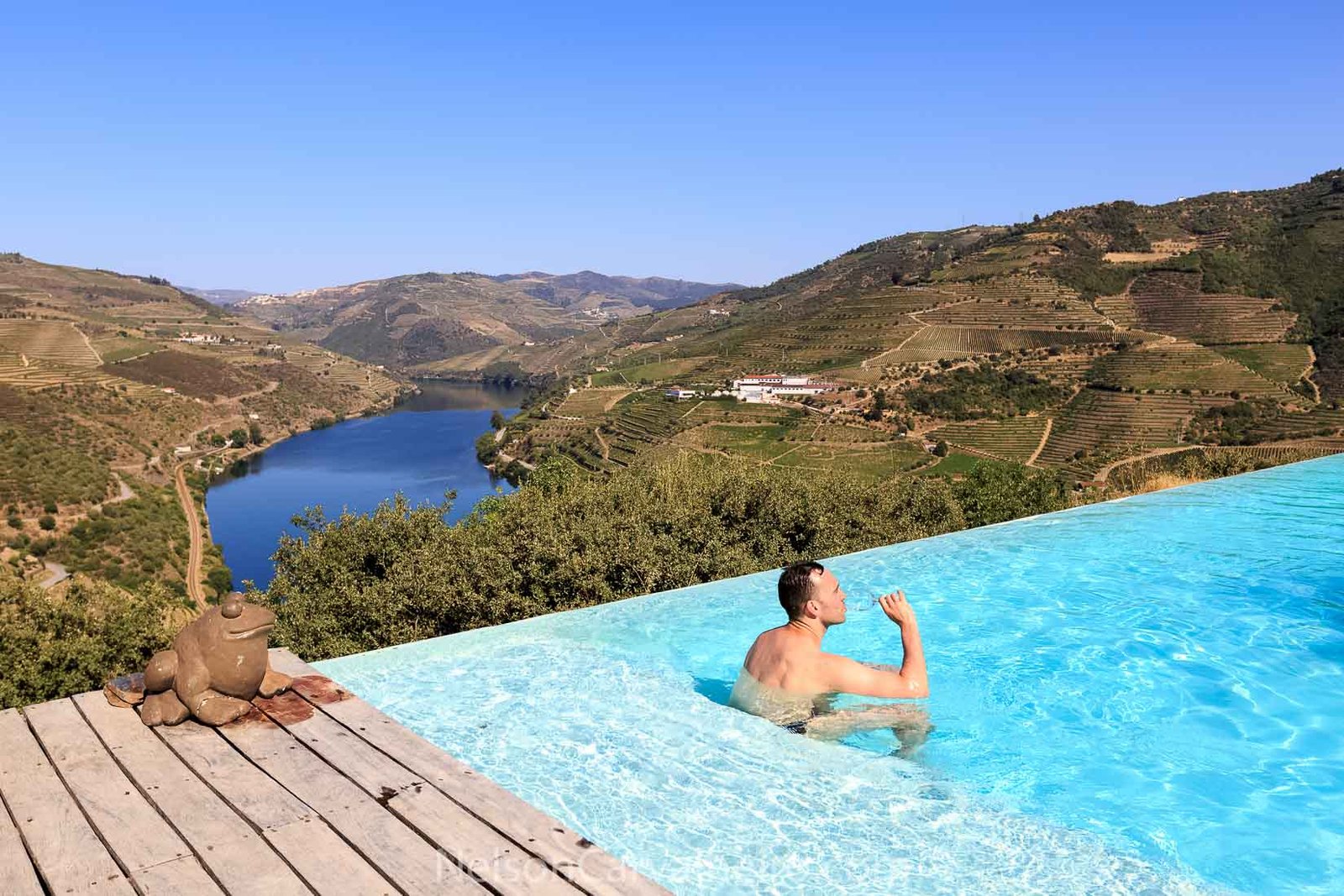
The attached image that I took at Quinta do Crasto should be the official postcard for what travelling the Douro is all about – enjoying premium quality Portuguese wines, in a private estate, within an infinity pool designed by a Pritzker winner Portuguese architect, while overlooking the most beautiful wine region in the World.
Quinta do Seixo
Quinta do Seixo is without a doubt the most modern and most commercial of all the Douro Valley’s Quintas. It belongs to one of the big four families in the Douro Sogrape Wines, responsible for the invention of the old ambassador for Portuguese wines in the world – Mateus Rosé. When you step into the winery you almost feels like entering a designer’s dream of how a place where wine is made should look like. There are almost no curve lines and the interior walls are all painted in black. There is even a raised walkway from where you can admire the robot steeping on the grapes during harvest season.

Nevertheless, the best show is outside the wine tasting bar. Because of the Quinta do Seixo’s strategic location, you can see the biggest stretch of the Douro – all the way from Pinhão to the curve that embraces the hill here Quinta Nova is located. Quinta do Seixo is very forward thinking, so they recommended me to try some of their port wine cocktails instead of the usually boring Port Wine Tasting. My favourite was the Ruby on the Rocks, where mint and slice of lemon is added to a very distinct Sandman Founders Reserve. Tchin Tchin.

Miradouro de São Leonardo de Galafura
Miradouro de São Leonardo de Galafura is the highest point of the entire Douro Valley. On a clear day, the horizon can be seen up to 30 kilometres in all directions. Besides this massive granite protruding mountain, what I enjoy most about it is the peace and tranquillity of it. There is only a little chapel in honour of Saint São Leonardo de Galafura and a small picnic area. Not café, no bathrooms, no one trying to sell you something…It’s just about you, the view and the nature where you are immersed.

[x_button shape="square" size="regular" float="none" href="http://tours.winetourismportugal.com/subscribe-wine-tourism-portugal-newsletter" block="true" title="SUBSCRIBE WINE TOURISM IN PORTUGAL NEWSLETTER " target="blank" info="none" info_place="top" info_trigger="hover"]SUBSCRIVE WINE TOURISM IN PORTUGAL NEWSLETTER [/x_button]
Disclaimer:
I toured the Douro Valley for five days (four nights) in July 2015 as a guest of Wine Tourism in Portugal. All opinions are my own.
8 Comments
Leave a Reply to Nelson | Nelsoncarvalheiro.com Cancel reply
This site uses Akismet to reduce spam. Learn how your comment data is processed.


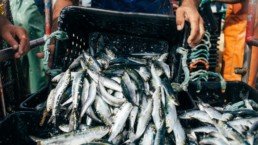


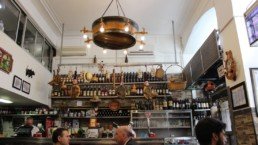

[…] old-school bread bakers (padeiras) of Favaios, our link to one of the most emblematic breads of the Douro Valley, “Pão de […]
[…] a group which has only the experience of building the Vintage House 20 years ago, this project is a tremendous over achievement. Congratulations! All the levels […]
Excelente trabalho, parabéns!
Obrigado!
[…] visited Book Restaurant as a guest of Wine Tourism in Portugal during my Douro Wine Travel Guide Journey. All opinions are my […]
[…] can vouch for their demand for privacy after having the pleasure of visiting 3 of their locations, Quinta do Panascal in the Douro, the Yeatman Hotel, and now the Taylors Port Wine Cellars in Gaia. In all of them the want to make […]
[…] blá. If anyone is even remotely serious about wine, they would want to know more about the Douro Valley, and how in the most inhospitable place in the world for making wine, the vine plants settled, […]
[…] Regua and Pinhao. These might help: http://www.dourovalley.eu/en/PageGen…,65&areaPOI=DV http://nelsoncarvalheiro.com/douro-v…-travel-guide/ The Big Daddy of Portugal's wine tourism sites is: […]